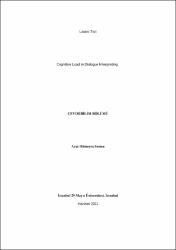Cognitive Load in Dialogue Interpreting
Abstract
This thesis is a translation thesis Project that is required by the course TRE 402 Thesis. The text I chose fort his Project, “Gaze and eye movement in dialogue interpreting: An eye-tracking study” by Elisabet Tiselius and Kayle Sneed, is investigating the cognitive processes in dialogue interpreting. Even though previous research has investigated the cognitive load/effort in simultaneous interpreting, it has not investigated in dialogue interpreting.
Experiments were done between experienced and inexperienced interpreters with the purpose of exploring the gaze patterns in dialogue interpreting related to directionality. By using eye-tracking glasses, they tried to explore where interpreters gaze. Are they gazing at between the speakers, or the participants, or gazing randomly? The research questions were;
1.What is the interpreter’s gaze pattern during dialogue interpreting?
2.Does the gaze pattern depend on the language direction?
3.Are there any observable differences in the gaze pattern between experienced and inexperienced interpreters?
To collect data, the role-playing has been recorded with two video cameras and the interpreters wore eye-tracking glasses. The participants’ seating arrangement was the classical equilateral-equiangular seating. Also, to not lose the eye-tracking data, they gave instructions to interpreters that they should not take notes. İstanbul 29 Mayıs Üniversitesi Senatosunun 22.06.2020 tarihli ve 2020/14-5 sayılı Açık Bilim Politikası gereğince erişime açılmıştır.


















